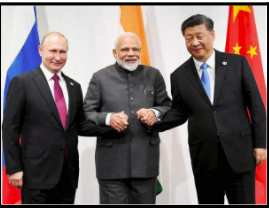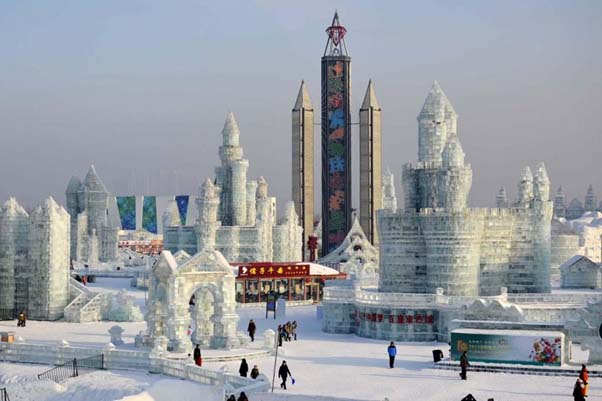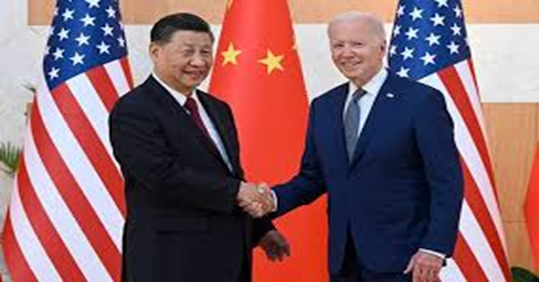India seeks to gain as Russia and China clash in Central Asia
Posted on : February 7, 2022Author : Dwaipayan Sinha

December 2021 witnessed the third meeting of the India-Central Asia dialogue in New Delhi where former USSR members namely Kazakhstan, Kyrgyzstan, Tajikistan, Turkmenistan and Uzbekistan held a virtual ministerial-level meeting with India. India invited the heads of state of these nations to the Republic Day celebrations after the conclusion of the dialogue.
Of the Central Asian republics, Tajikistan, Uzbekistan and Turkmenistan shares border with Afghanistan, which recently saw the Taliban coming back to power. Although these states have broken away from the USSR, Russia continues to heavily influence their foreign policy matters. India used its presence at the Farkhor air base in Tajikistan to conduct the withdrawal of Indian staff from the Afghan capital.
At the same time, Pakistan also organised an OIC conference on Afghanistan. Interestingly, the foreign ministers of these countries decided to attend the India-hosted dialogue and sent their deputies to the Pakistan organised conference, which shows that India has made considerable inroads in these states.
Elsewhere, Russia-China bonhomie has increased due to the deteriorating US-China relations and sanctions imposed on Russia by The West after it annexed Crimea. Russia and China have their own ambitions- Russia in Ukraine and China in Taiwan. Both Russia and China would ensure that they look the other way in case either of them acts aggressively in their own neighbourhood. Even though Russia and China are on the same side when tackling US hegemony, Russia is wary of China gaining influence in this region with its Belt and Road Initiative. Russian president Vladimir Putin is unwilling to play second fiddle to an emerging and belligerent China.
The US policymakers are divided on how they should interpret the growing Russia-China proximity. Political analysts believe that Putin attending Beijing Winter Games opening ceremony is a show of resistance to the US and its allies. Chinese president Xi Jinping has invited Putin, but Putin’s presence won’t necessarily be a Russian endorsement of China’s internal and foreign affairs.
India and Russia have always shared cordial ties even though trade relations are not as beneficial as either would like it to be. Although India is a part of the US-led Quad grouping to counter China, it has remained largely independent in its foreign affairs. India signed a host of defence deals with Russia recently even though the threat of sanctions was looming large. India has refrained from out rightly criticising Russian decisions. In return, Russia has backed India’s concerns and has volunteered as a mediator to solve the Indo-China crises. Even while dealing with India’s hostile neighbour Pakistan, Russia has kept Indian interests in mind including in the sale of weaponry.
India was inducted to the Shanghai Cooperation Organization (SCO) by Russia as a balancing act against China. The Indo-Russia summit, the Indo-Central Asian dialogue and the telephone conversation between Indian prime minister Narendra Modi and Russian president Putin all took place in December 2021. This signifies the growing importance of India in the minds of Russian thinkers. Indian involvement in Central Asia would be preferred to China’s involvement by Russia. Russia believes that India, unlike China, will not seek to replace Russian dominance in Central Asia as India does not neighbour any of these nations. Russia perceives China’s growing as a long-term threat to Russian interests as China borders Kazakhstan, Tajikistan and Kyrgyzstan. China’s debt trap diplomacy is reportedly financially bleeding the Central Asian nations with Tajikistan and Kyrgyzstan owing over 40 percent of their foreign debt to Beijing.
China is now interested to grab gold mining concessions and additional land in lieu of payments after they have settled the border disputes with these countries in their favour. Beijing is still pursuing the Pamir Knot region from Tajikistan. The region borders Afghanistan and control over it would enable China to neutralise threats in Xinjiang province. China hopes to root out Uighur nationalism, which has seen an upsurge. The Central Asian countries have witnessed plenty of anti-China and pro-Uighur protests recently. 3 million Central Asian residents live in the Xinjiang province and China hopes to repatriate them. Additionally, China seeks to exploit mineral resources including oil and gas. China would also be able to gain land access to Europe through this region.
Russia continues to control the military and security dynamics of these countries through the Collective Security Treaty Organization (CSTO) as was seen with the Russian troops coming in support of the Kazakhstan government during the recent crisis. Russian and Chinese interests are at odds here as China, which already controls these countries economically, wants to supersede Russia in the security arena. The Chinese want to increase trade and military ties with nations in this region. China provides cheap weapons to these nations, most of them ironically being substandard replicas of Russian weapons.
Russia realises the threat China poses in this region to its own interests. China, on its part, would not like to see India increase its influence in this bloc. Russia’s proximity to India has not gone down well with China according to reports. Russia hopes that it would be able to significantly reduce China’s influence by aligning with India and jointly manufacturing and maintaining weapons in Central Asia. The Indo- Russia summit touched on the issue of joint defence projects in this region. According to a report on the Russian news agency TASS, Modi and Putin reached an agreement to expand the joint production in India of spare parts for maintenance of Russian origin arms and defence equipment. “Both sides agreed to take forward ongoing engagements to encourage joint manufacturing in India of spare parts, components, aggregates and other products for maintenance of Russian origin Arms and defense equipment under Make-in-India program through transfer of technology and setting up of joint ventures for meeting the needs of the Indian Armed Forces as well as subsequent export to mutually friendly third countries,” read a joint statement released on the Kremlin website.
Increased Indian investments and aid for Central Asia was mentioned in the joint statement at the end of the India-Central Asia dialogue. Discussion on security cooperation took place and holding of regular NSA meetings were agreed upon. Various development projects received approval. Sanctioning of a USD 1 billion line of credit also took place. Detailed discussion took place on the volatile situation in Afghanistan as the Taliban regime is of grave concern for India, Russia and Central Asian countries. To tackle the threat from terrorism, India, Russia and Central Asian countries planned to take part in joint counter-terrorism endeavours in 2022.
Russia and China actively dominate Central Asia as the other major actors are missing. India’s involvement is wanted by Russia and resisted by China. But both are against NATO or US presence. India must seek to utilise the opportunities it is presented with as it can counter China and also use mineral resources Central Asia provides for its own use.
Dwaipayan Sinha
Intern, Asia in Global Affairs
References
Russia led CSTO despatches troops to Kazakhstan to control terrorists
(https://economictimes.indiatimes.com/news/international/world-news/russia-led-csto-despatches-troops-to-kazakhstan-to-control-terrorists/articleshow/88739527.cms)
Indian production of spare parts for Russian defense equipment to expand(https://tass.com/defense/1371617)
Joint Statement of the 3rd meeting of the India-Central Asia Dialogue(https://www.mea.gov.in/bilateral-documents.htm?dtl/34705/Joint_Statement_of_the_3rd_meeting_of_the_IndiaCentral_Asia_Dialogue)
Taliban are back: what next for Afghanistan? (https://www.bbc.com/news/world-asia-49192495 https://www.bbc.com/news/world-asia-49192495)
What Putin Really Wants in Ukraine?( https://www.foreignaffairs.com/articles/russia-fsu/2021-12-28/what-putin-really-wants-ukraine)
What’s behind the China-Taiwan divide?(https://www.bbc.com/news/world-asia-34729538)
India and Russia Expand Defense Ties, Despite Prospect of U.S. Sanctions(https://www.nytimes.com/2021/12/06/world/asia/india-russia-missile-defense-deal.html)
China’s Debt Trap Diplomacy in Kyrgyzstan( https://www.internationalaffairs.org.au/australianoutlook/chinas-debt-trap-diplomacy-in-kyrgyzstan/)
Tajikistan: Another Victim of Chinese Belligerence in Central Asia (https://www.vifindia.org/article/2020/august/12/tajikistan-another-victim-of-chinese-belligerence-in-central-asia)




